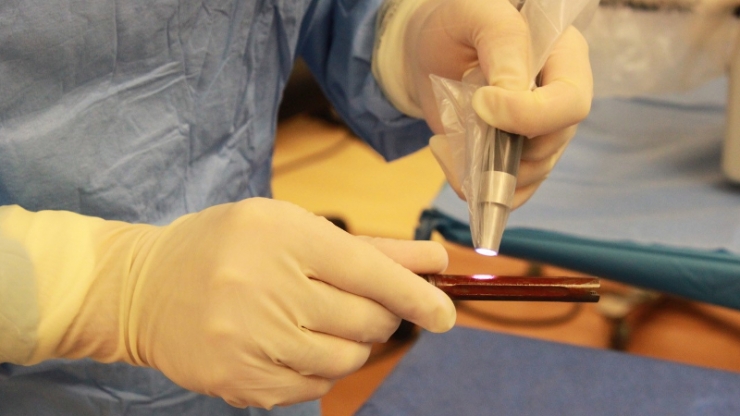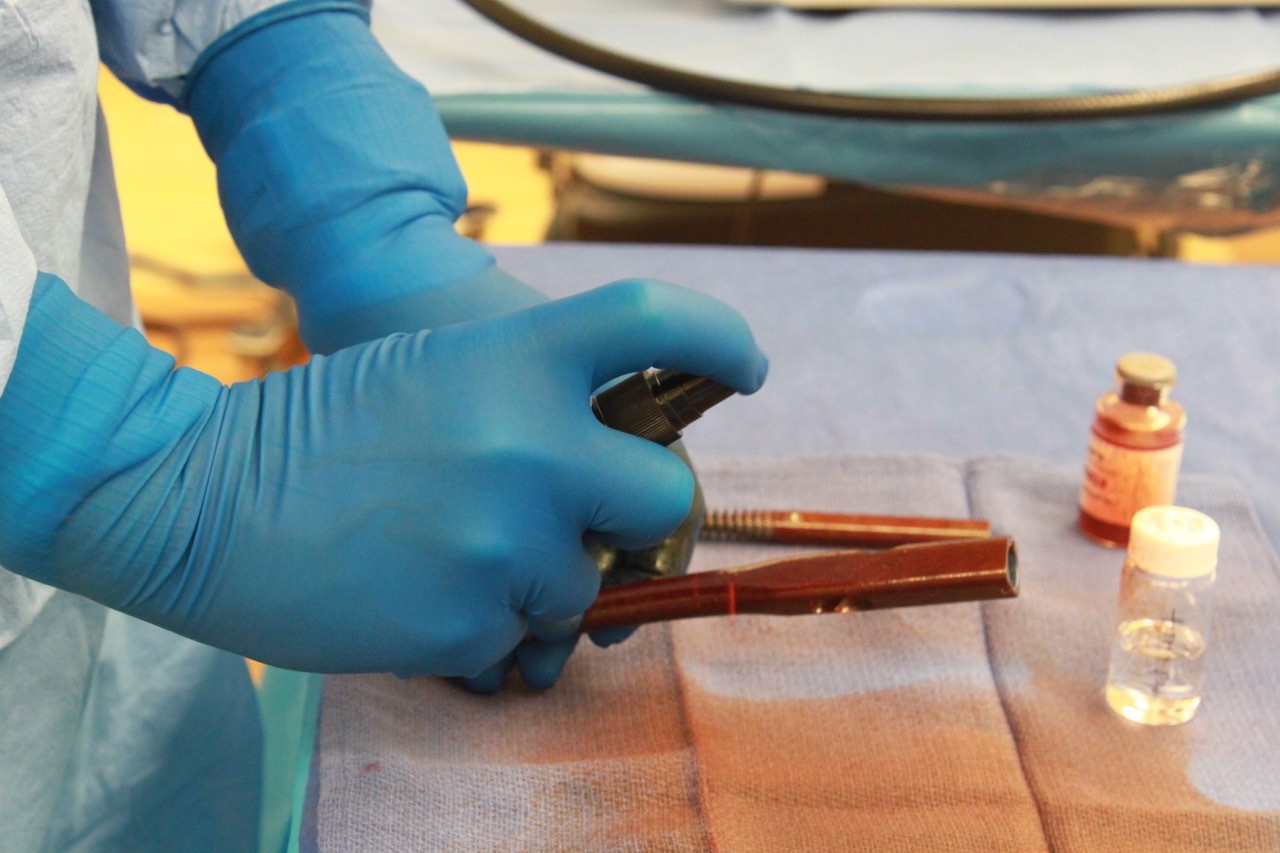创新背景
许多接受骨癌治疗的儿童的大部分骨头都被切除了,然后需要整形植入物。但由于患者通常也在接受化疗,他们的免疫系统很弱,特别容易受到植入物表面定植的细菌的伤害。
这些孩子面临着化疗和保留肢体,甚至有时需要截肢来生存。他们真正需要的只是在植入物上添加一些东西来阻止感染,因为预防感染比治疗感染容易得多。
然而,植入物感染并不只发生在儿童或癌症患者身上。例如,在关节置换手术中,1%的初次翻修手术和高达7%的翻修手术会发生感染,这需要反复翻修手术和延长静脉注射抗生素的时间。然而,治疗并不总是有效的,因为这些患者的5年死亡风险高于那些被诊断患有艾滋病或乳腺癌的患者。
创新过程
治疗这些感染的挑战之一是细菌会在植入物本身的表面定植。这意味着细菌菌落中没有血管流过,无法将抗生素输送到病人的静脉中。唯一的办法通常是取出原来的植入物,这通常是糟糕选择中的最好选择。
一些医生已经采取了自己的解决方案,比如在闭合手术伤口时使用抗生素粉,或者在用于固定植入物的骨水泥中注入抗生素。这些策略都没有被证明是临床有效的。还有一种选择是植入设备制造商在他们的设备中添加抗生素特性。但这将大大缩短产品的保质期,还需要经过漫长而复杂的FDA批准过程,因为植入物将进入一个新的分类。

使用手持光源在人髓内髋关节植入物上固化自组装聚合物和抗生素的混合物
Segura的新抗生素涂层避开了所有这些挑战。
研究人员已经证明,一种即时的、释放抗生素的涂层可以保护植入物免受细菌的侵袭,并且可以在手术室快速安全地应用,而不需要修改现有的植入物。
这种新的抗菌涂层由两种聚合物组成,一种是防水的,另一种是与水混合良好的。两者都与医生选择的抗生素溶液结合,然后通过浸渍、涂涂或喷涂的方式直接应用于骨科植入物。当暴露在明亮的紫外线下时,这两种聚合物结合在一起并自我组装成网格状结构,从而捕获抗生素。
该反应是“点击化学”的一个例子,这是一种描述在室温下快速发生的反应,只产生单一反应产物,有极高的收率,发生在单一容器内的反应的一般方式。

将自组装聚合物与抗生素混合后,用简单的香水瓶将防感染涂层喷涂到人体髓内髋关节植入物上
这种“智能”、“可点击”的聚合物涂层能够保护植入物不受细菌感染,并使个性化方法成为可能。
新型涂层可以个性化,因为它几乎可以使用任何抗生素。医生可以根据植入设备的身体部位以及在世界上任何地方进行手术的地方常见的病原体来选择抗生素。
化学聚合物网格对金属也有亲和力。对不同类型植入物的测试表明,在手术过程中涂层很难被擦掉。然而,一旦进入人体,这种情况就会导致聚合物降解,在两到三周的时间内慢慢释放抗生素。
在这项研究中,研究人员在植入腿部或脊柱的老鼠身上严格测试了这种涂层。20天后,涂层没有抑制骨头在种植体中的生长,并防止了100%的感染。研究人员说,这段时间足够防止绝大多数这类感染的发生。
创新关键点
这种新的抗菌涂层由两种聚合物组成,一种是防水的,另一种是与水混合良好的。两者都与医生选择的抗生素溶液结合,然后通过浸渍、涂涂或喷涂的方式直接应用于骨科植入物。当暴露在明亮的紫外线下时,这两种聚合物结合在一起并自我组装成网格状结构,从而捕获抗生素。
创新价值
新型涂层可以个性化,因为它几乎可以使用任何抗生素。医生可以根据植入设备的身体部位以及在世界上任何地方进行手术的地方常见的病原体来选择抗生素。
这项跨学科的工作提供了一种应用点涂层,将植入物从感染热点转变为“智能”抗菌治疗。
Application of antibiotic coating innovations to orthopedic implants could eliminate the chance of infection
One of the challenges in treating these infections is that bacteria colonize the surface of the implant itself. This means there are no blood vessels flowing through the bacterial colony to deliver antibiotics to the patient's veins. The only option is usually to remove the original implant, which is often the best of a bad choice.
Some doctors have adopted their own solutions, such as using antibiotic powder when closing surgical wounds or injecting antibiotics into the bone cement used to hold implants in place. None of these strategies have proven to be clinically effective. There is also an option for implantable device manufacturers to add antibiotic properties to their devices. But that would significantly shorten the shelf life of the product and would require a long and complicated FDA approval process, as the implant would move into a new classification.
Segura's new antibiotic coating sidesteps all of these challenges.
Researchers have shown that an immediate, antibiotic-releasing coating can protect implants from bacteria and can be quickly and safely applied in the operating room without the need to modify existing implants.
The new antibacterial coating consists of two polymers, one that is waterproof and the other that mixes well with water. Both are combined with an antibiotic solution of the doctor's choice and then applied directly to orthopedic implants by dipping, coating, or spraying. When exposed to bright ultraviolet light, the two polymers bind together and self-assemble into grid-like structures that capture antibiotics.
The reaction is an example of "click chemistry," a general way of describing a reaction that occurs rapidly at room temperature, produces a single reaction product, has an extremely high yield, and occurs in a single container.
The "smart", "clickable" polymer coating protects the implant from bacterial infection and enables a personalised approach.
The new coating can be personalized because it can use almost any antibiotic. Doctors can choose antibiotics based on the part of the body where the device is implanted and the pathogens that are common where the surgery is performed anywhere in the world.
Chemical polymer grids also have an affinity for metals. Tests on different types of implants have shown that the coating is difficult to rub off during surgery. Once in the body, however, the condition causes the polymer to degrade, slowly releasing the antibiotic over a period of two to three weeks.
In the study, the researchers rigorously tested the coating on mice with leg or spine implants. After 20 days, the coating did not inhibit bone growth in the implant and prevented 100 percent infection. That's enough time to prevent the vast majority of such infections, researchers say.
智能推荐
生物医学工程创新 | 创新利用纳米颗粒可有效检测血液样本中超低水平microRNA
2022-09-30新南威尔士大学的研究人员发现了一种利用纳米颗粒检测血液样本中超低水平microRNA的新方法,可以使癌症和其他疾病的诊断更快,更有效。
涉及学科涉及领域研究方向医学成像技术创新 | 新型诊断成像技术可将切割精度提高10倍
2022-10-11加州理工学院的研究人员开发的一种新的诊断成像技术使外科医生能够将切割精度提高10倍,使他们能够保留多达1000倍的健康组织,并使患者更容易康复。
涉及学科涉及领域研究方向基因工程创新 | 创新开发“基因递送系统”特异性地靶向脑细胞
2022-10-12加州理工学院研究人员开发了一种基因递送系统,可以特异性地靶向脑细胞,同时避开肝脏。
涉及学科涉及领域研究方向细胞学创新 | 创新开发”M-CREATE法”可快速识别AAV变体
2022-10-27研究人员开发了一种方法,可以快速有效地识别设计腺相关病毒(AAV)变体,这种病毒可以传递到或“转导”小鼠特定类型的细胞,使科学家能够根据研究或临床需要选择一种病毒。
涉及学科涉及领域研究方向